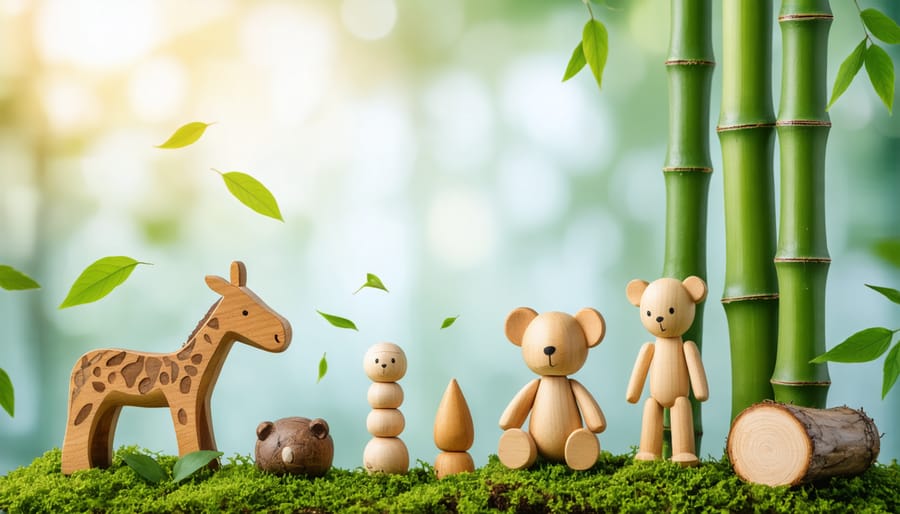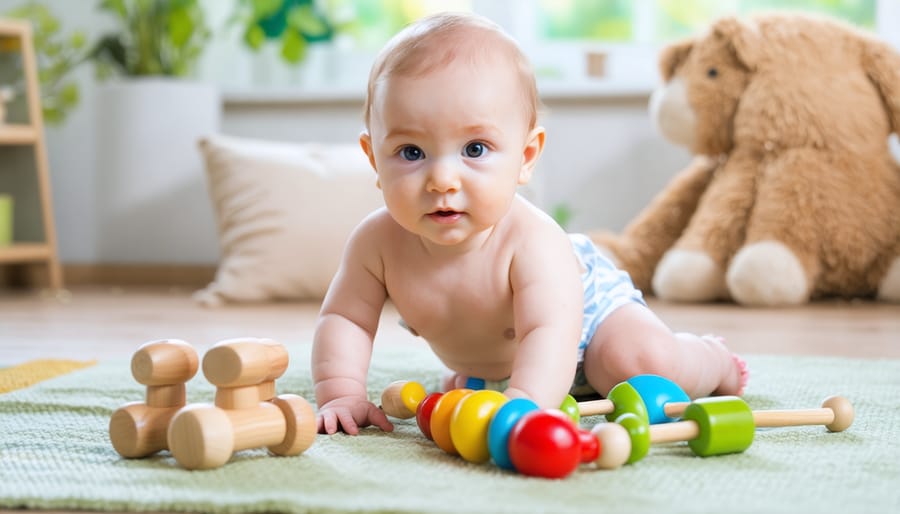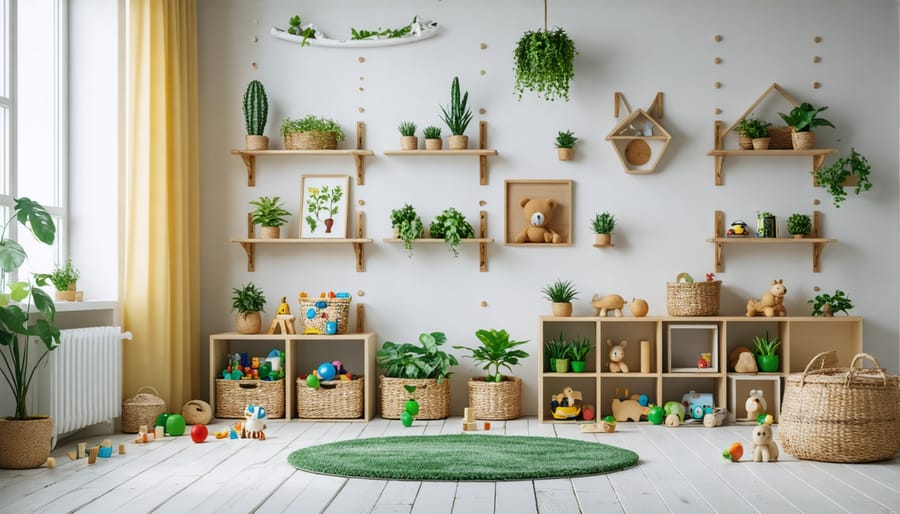Transform your child’s playtime into an eco-conscious adventure while creating a healthy home environment. Natural wooden blocks, organic cotton plush animals, and recycled plastic building sets offer sustainable alternatives to conventional toys without compromising on fun or educational value. Today’s eco-friendly toys combine thoughtful design with non-toxic materials, ensuring both environmental responsibility and child safety. From bamboo tea sets that spark imaginative play to biodegradable art supplies that encourage creativity, these sustainable choices seamlessly blend with modern home aesthetics while reducing your family’s environmental footprint. Parents increasingly recognize that choosing eco-friendly toys isn’t just about environmental stewardship—it’s about fostering a connection between children and nature, promoting mindful consumption habits, and creating play spaces that reflect their values and style preferences.
What Makes a Toy Truly Eco-Friendly?
Safe and Sustainable Materials
When it comes to eco-friendly products, the materials used in children’s toys deserve special attention. Today’s sustainable toy manufacturers prioritize natural, non-toxic materials that are both safe for children and kind to our planet. Popular options include FSC-certified wood from responsibly managed forests, organic cotton, and natural rubber from sustainable sources.
Bamboo has emerged as a fantastic alternative to traditional plastics, thanks to its rapid growth and natural antimicrobial properties. Cork is another renewable material gaining popularity, offering durability while being completely biodegradable. Many manufacturers are also exploring innovative materials like recycled ocean plastics and bio-based plastics derived from corn or sugarcane.
Look for toys finished with non-toxic, water-based paints and natural dyes that are safe for little ones who might put toys in their mouths. Natural beeswax and food-grade mineral oil are excellent choices for wood finish, providing protection while maintaining the toy’s eco-friendly qualities. These materials not only create safer playthings but also often result in beautiful, timeless pieces that can enhance your home’s aesthetic.

Responsible Manufacturing Practices
When it comes to eco-friendly toys, responsible manufacturing is about more than just using sustainable materials. Today’s leading green toy manufacturers follow strict ethical guidelines throughout their production process. Many use solar-powered facilities and implement water conservation practices, significantly reducing their environmental footprint.
Look for toys that carry trusted certifications like FSC (Forest Stewardship Council) for wooden toys or GOTS (Global Organic Textile Standard) for fabric items. These labels ensure the materials are sustainably sourced and processed. Companies committed to eco-friendly manufacturing often use local materials and maintain transparent supply chains, allowing you to trace exactly where your child’s toys come from.
Many manufacturers are now adopting zero-waste policies, recycling production scraps and using minimal packaging made from recycled materials. Some even offer take-back programs, where old toys can be returned for proper recycling or refurbishment. Energy-efficient production methods and the use of non-toxic, water-based dyes and finishes are also hallmarks of responsible toy manufacturing.
When shopping, prioritize brands that openly share their manufacturing practices and environmental commitments on their packaging or websites. This transparency indicates a genuine dedication to sustainability rather than mere greenwashing.
Top Eco-Friendly Toys for Different Age Groups
Natural Toys for Babies (0-12 months)
For our littlest ones, natural toys aren’t just eco-friendly – they’re essential for safe, healthy development. Babies explore their world through touch and taste, making non-toxic materials absolutely crucial. Organic cotton stuffed animals and teething rings crafted from untreated maple wood offer perfect sensory experiences while keeping harmful chemicals away from sensitive mouths.
Consider incorporating wooden rattles made from sustainably harvested beech or maple, finished with food-grade oils. These classic toys produce gentle sounds that help develop auditory skills without overwhelming young ears. Organic cotton play mats, decorated with natural dyes, provide a safe space for tummy time while adding an earthy touch to your nursery decor.
Silicone teething toys, made from food-grade materials, offer a modern alternative to plastic. Look for ones in neutral, nature-inspired colors that complement your home’s aesthetic while soothing sore gums. Hand-knitted dolls using organic wool and cotton aren’t just adorable – they’re perfectly sized for tiny hands and introduce different textures.
For visual stimulation, try wooden mobiles featuring simple shapes in natural colors. These can be hung above the changing table or crib, creating both a functional toy and an artistic element in your nursery. Remember to choose items with smooth edges and sizes appropriate for your baby’s developmental stage, ensuring both safety and sustainability align in your toy selection.

Sustainable Choices for Toddlers (1-3 years)
Toddlers are natural explorers, and selecting the right eco-friendly toys during this crucial developmental stage can make a significant impact on both their growth and our planet. Opt for wooden blocks made from sustainably harvested timber, which offer endless possibilities for creative play while developing spatial awareness and motor skills. These timeless toys can be passed down through generations, reducing waste and creating lasting memories.
Consider investing in open-ended toys like organic cotton playdough or natural rubber sensory balls. These materials are gentler on the environment and safer for curious toddlers who still explore through touch and taste. Look for non-toxic water-based paints and natural dyes on wooden puzzles and shape sorters, which help develop problem-solving skills while maintaining eco-consciousness.
Musical instruments crafted from bamboo or recycled materials make excellent choices, combining sustainability with early musical education. Simple percussion sets can inspire rhythm and coordination while teaching environmental responsibility through example.
Storage solutions matter too – choose organizational bins made from recycled materials or natural fibers to keep toys tidy while maintaining your eco-friendly commitment. Many sustainable toy brands now offer modular storage systems that grow with your child and complement your home’s aesthetic.
Remember to check for certifications like FSC (Forest Stewardship Council) for wooden toys and GOTS (Global Organic Textile Standard) for fabric items to ensure authentic eco-friendly credentials.
Green Toys for Preschoolers (3-5 years)
Preschoolers are naturally curious explorers, and eco-friendly toys can feed their imagination while protecting our planet. Wooden building blocks made from sustainably harvested timber offer endless creative possibilities – from towering castles to imaginative cities. Look for blocks finished with non-toxic, water-based paints that are safe for little hands.
Art supplies get an eco-makeover with natural modeling clay made from organic flour and plant-based dyes. These alternatives are just as fun as conventional options but decompose naturally when eventually discarded. Pair them with bamboo paint brushes and recycled paper sketchbooks for a complete creative station.
For active play, consider recycled plastic ride-on toys manufactured using clean energy. Many brands now create these larger toys from milk jugs and other post-consumer plastics, giving materials a second life while providing hours of entertainment.
Natural rubber balls and jump ropes made from organic cotton offer classic play value without environmental impact. These timeless toys encourage physical activity and coordination while being completely biodegradable.
Don’t forget puzzle play! Wooden jigsaw puzzles with eco-friendly inks help develop problem-solving skills. Choose ones with nature themes to spark conversations about environmental awareness. Many come in plastic-free packaging that can be composted or recycled.
Remember to look for third-party certifications like FSC for wood products or Global Organic Textile Standard (GOTS) for fabric toys to ensure genuine sustainability claims.
Incorporating Eco-Friendly Toys into Your Home Decor

Storage Solutions That Blend with Your Interior
Keeping your eco-friendly toys organized doesn’t mean compromising your home’s style. In fact, thoughtful storage solutions can enhance your sustainable home decor while maintaining easy access for little ones. Consider using natural woven baskets made from seagrass or bamboo, which add texture and warmth to any room while keeping toys neatly contained. Wall-mounted rope shelves offer a rustic touch and keep floor space clear, while vintage wooden crates can be stacked to create modular storage that grows with your needs.
For a modern look, opt for minimalist fabric storage bins in neutral tones or soft pastels that complement your existing color scheme. Repurposed furniture pieces, like an old dresser painted with non-toxic paint, can double as toy storage while adding character to your space. Remember to place storage solutions at child-height to encourage independence and tidying up. Multi-functional pieces, such as ottoman storage benches, offer hidden toy storage while serving as comfortable seating for adults.
Creating Sustainable Play Areas
Creating an eco-friendly play area is easier than you might think, and it starts with thoughtful design choices. Begin by selecting natural materials like bamboo flooring or cork tiles, which are both sustainable and comfortable for little ones to play on. Consider installing large windows or skylights to maximize natural light, reducing the need for artificial lighting during daytime play.
Storage solutions can be both practical and sustainable – opt for secondhand wooden crates, woven baskets, or repurposed furniture pieces to organize toys. Paint walls with low-VOC or natural paints in calming earth tones, and add indoor plants to purify the air naturally.
Create designated zones using sustainable materials: a reading nook with organic cotton pillows, a creative corner with a reclaimed wood table, and an open play area with natural fiber rugs. Install energy-efficient LED lighting for evening playtime, and use washable, organic textiles for easy cleaning.
Remember to keep the space flexible and minimalist – this not only promotes creative play but also reduces the need for excessive toys and materials. Consider rotating toys regularly to maintain engagement while limiting consumption.
Maintaining and Caring for Eco-Friendly Toys
Natural Cleaning Methods
Keeping your eco-friendly toys clean doesn’t mean resorting to harsh chemicals. There are plenty of effective natural cleaning solutions that are safe for both your children and the environment. For wooden toys, a simple mixture of warm water and mild castile soap works wonders. Gently wipe the surface with a damp cloth, being careful not to saturate the wood, and dry thoroughly afterward.
For fabric toys, create a gentle cleaning solution using one part white vinegar to three parts water. Spot clean as needed, or for machine-washable items, use this mixture in place of conventional detergent. Always air dry to minimize environmental impact and extend the toy’s lifespan.
To disinfect naturally, sunlight is your best friend. Place toys outside on a clean surface for 2-3 hours, as UV rays naturally kill bacteria. For extra sanitizing power, mix equal parts water and white vinegar in a spray bottle, adding a few drops of tea tree oil for its natural antimicrobial properties.
Remember to clean toys regularly, especially those that frequently go into little mouths. Store them in breathable containers and avoid plastic bags to prevent moisture buildup. These methods not only keep toys clean but also preserve their eco-friendly qualities while protecting your child’s health.
Extending Toy Lifespan
Extending the life of your eco-friendly toys not only maximizes your investment but also reduces environmental impact. Start by establishing a regular cleaning routine using gentle, natural cleaners like vinegar and water solution or mild castile soap. For wooden toys, occasionally treat them with food-grade mineral oil to prevent drying and cracking.
Create a dedicated storage space away from direct sunlight and extreme temperatures to prevent material degradation. Consider using breathable cotton bags or sustainable storage boxes to protect toys when not in use. Teaching children proper toy care habits early on can significantly impact toy longevity – simple practices like putting toys away after play and handling them gently make a big difference.
For fabric toys, spot-clean stains immediately and air-dry thoroughly to prevent mold. Loose stitching should be repaired promptly to prevent further damage. Wooden toys might need light sanding and beeswax polish occasionally to maintain their finish and prevent splinters.
Don’t forget to regularly check for wear and tear. Small issues can often be fixed with eco-friendly glues or natural repair materials. When toys do show signs of extensive wear, consider creative upcycling projects – wooden blocks can become decorative pieces, and fabric toys can transform into storage pouches or decorative elements for your child’s room.
Choosing eco-friendly toys is more than just a trend – it’s a meaningful step toward creating a sustainable future for our children while maintaining a beautiful, conscious home environment. These thoughtfully crafted toys not only reduce environmental impact but also help develop children’s appreciation for nature and sustainable living from an early age.
By selecting toys made from natural materials like wood, organic cotton, and recycled plastics, we’re reducing waste, supporting ethical manufacturing practices, and creating healthier play environments for our little ones. These sustainable choices often feature timeless designs that complement any home décor while standing up to years of play, making them excellent investments for both the planet and your wallet.
Remember that every eco-friendly toy purchase sends a message to manufacturers about the importance of sustainable practices. As more families embrace these conscious choices, we create positive change in the toy industry and inspire the next generation to value environmental stewardship.
Let’s make sustainable play a priority in our homes. Whether you’re choosing natural wooden blocks, organic stuffed animals, or recycled plastic construction sets, you’re contributing to a cleaner, greener future while creating beautiful play spaces that align with your values and aesthetic preferences. Start small, choose wisely, and watch as your sustainable toy collection grows into a cherished part of your home’s eco-friendly journey.
